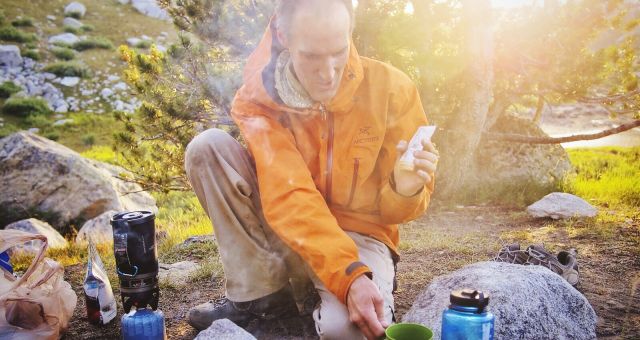What’s in your closet?
Within the past 6 years, we’ve gotten into phases of hiking, backpacking, climbing, and mountaineering. This post was spurred by the realization that within those times we have amassed a vast quantities of redundant (and therefore mostly useless) gear.
This was made apparent when we were selling our stuff for our RTW trip in 2011. We found a bunch of useless junk in our closet.
One of the best tips I learned about buying travel gear is to buy stuff only once and make it count. The idea is yes, we have to shell out a lot at first, but as long as it’s a good quality product and it’s exactly what we need it should be the only purchase we ever make for foreseeable future. In the long run, not only would it save you money (for more ways to save money for travel, see here), but it’s also good for the environment.
Here are some of the lessons on how to shop for travel gear we wish we had known 4 years ago:
MORE: My Ultimate Packing List
Do your research and learn the jargons
‘Mini-ripstop shell fabric’, ‘rib-knit hem’, and ‘interior windflap’.
‘Engineered plastic hubs’, ‘exclusive Tension Truss architecture’…
Find out what they are and whether or not you should care. There’s a difference between ‘water-resistant’ and ‘waterproof’. Knowing the difference ‘650 fill’ vs ‘800 fill’ will mean you’ll be able to evaluate if the extra $100 is worth it.
Decide on 1 or 2 must-have attributes
The idea is to narrow down the often-bewildering number of options. When I’m looking to purchase my next travel gear, I like to create a list of 5 nice to have features and choose 1 or 2 of ‘must-have’ features. For example, when I was looking for a pair of hiking shoes for my upcoming trek to Patagonia, my ‘nice-to-have’ features were: fit, waterproof, durability, weight, and price with the first two as my must-have(s). (And I found these! The best – and ugliest – shoes I’ve owned).
For my sleeping bag I wanted compressibility and lightweight as my ‘must-have’ features — which led me to getting the best sleeping bag I’ve ever owned.
And don’t compromise on your must-have features. Really.
Ideally whatever item you buy should last you for many, many years. Would you be willing and able to live with your compromises for that long? All of my purchase regrets come from compromising on the attributes that are important to me simply because they were on sale.
Like this Eagle Creek pack I bought (heavily discounted at 75% off) that’s just too big for my 5’1″ frame. I thought, ‘Yeah, I can live with this.’ Nope. HATE it. Hurts my back. And I can’t return it because it was on clearance.
Approach ‘clearance’ rack with a healthy dose of caution. Remember the values that are important to you and don’t let the price tag sways you or convince you otherwise.
Don’t compromise on price (too much)
Buying exactly what I need and exactly what I want will mean that I won’t waste more time and money later on trying to ‘fix’ my previous purchase.
Say you’ve found the perfect [fill in the blanks here, backpack, tent, camera, etc], but the price is just a little outside your budget. So you think, ‘Well, I can save 20 bucks and get this other thing instead.’ Turned out that I was never happy with my second choice. I’ve learned this the hard way.

Assortment of climbing/backpacking gear — Never stop climbing
Learn when the right time to buy and check out last year’s collection
Big outdoor stores would try to get rid of their stock in order to get ready for new collection and you want to be there to take advantage of it.
Buying winter gear? Spring is the best time to buy.
Buying a summer tent and backpack? Fall is your best bet.
Oh, another thing — once you find your perfect gear, go online and type in the name, model, and last year (e.g. ‘Osprey Talon 44 2010’). More often than not, they’re exactly the same item and would be heavily discounted. So what if it’s only available in bright orange?
Test drive before committing on a purchase
It seems that it’s almost impossible to figure out what features you need (or don’t need) until you’re out there actually doing the activities. What I thought were ‘must-haves’ turned out to be not a big deal, while I’ve also discovered ‘deal breaker’ features that I would not have thought of before.
If at all possible, use whatever you already have or borrow from a friend and do a test drive before rushing out to get a new item.
If you can’t test drive an item beforehand…
Shop from a store with good refund policy
We love our REI. They have an 100% satisfaction return policy and as a member, we don’t need to keep any of the receipts. I’ve returned many items I’m not happy with, some of them bought over a year ago, with no hassles. And as a result we’re more than willing to get almost of all our gear from them.
Some bigger online stores such as, Backcountry.com also has an unlimited refund policy and has been known as one of the best online companies to shop from because of it.
Pick reputable brands with good customer service
I bought a Patagonia base layer that turned out not to be a good fit (and not to mention that it was too magenta for my taste). For months it was sitting at the bottom of my closet until I decided to take it back. The local Patagonia store accepted it back even when I couldn’t show them a receipt or even remember where I got it from in the first place.
Because of this, and also because of Patagonia’s commitment to the welfare of their workers and animals, I’m a big fan of their products.
I’ve had good experience with Mountain Hardware and heard good stories about Marmot and Osprey. They often repair or replace your defected gear for little or no cost.
After all, when you spend $300 on a performance jacket, the least you can expect is ease of return when the stitching starts to unravel after a month, right?
All geared up for Swiss Alps finicky weather
Think of your travel gear collection as its own ecosystem
Thinking of your gear as a system prevents purchasing duplicate items and wasting your money as a result.
Everything has to have a purpose: everything has to fit together and work together. Just like how Mac products play best with other Mac products, you know?
It might sound crazy but it’s true. When buying a new hydration system I know that I shouldn’t get a 3 litter bladder, that way all of our bladders and bags will be interchangeable. I figure if I need to bring more, I’d carry a water bottle in addition.
When shopping for a sleeping bag, I know size would be one of my ‘must-have’ features because I have a small (40L) pack that it must fit into. I also know that since I have a warm sleeping bag I can compromise a little bit on the sleeping mat and got a thinner (and thus lighter and cheaper) mat.
Often you can deal with a gear’s limitation by getting a supporting gear, e.g. getting a liner for your sleeping bag means you do not have to get a more expensive, warmer bag.
When you’re shopping for a new item, think how it will fit together with what you already have.
C4 cams – not gimmicks.
If it looks like a gimmick and sounds like a gimmick…
The more complicated a gadget is and the more parts it has, the more likely it will break. Sometimes all you need to complete that gear list are little things that can easily be made from readily available stuff.
Things like:
– duct tape
– safety pins
– zip ties
– zip-lock plastic baggies
– large trash can liner
are some of the things we always carry with us and have been worth their weight in gold.
Other examples of simple is better:
This post has a great list of low cost travel hacks and we’ve utilized most of the them.
Uncornered Market uses tupperwares to protect their external hard drive.
Having said all of the above, what works for us might not work for you. So, just like any other tips you find on the big interweb, take them with a grain of salt and experiment.
And have fun.
And share your mistakes 🙂
—





Questions and Comments
Comments are disabled. If you have any questions about the post, you can DM me on Instagram: @jacknjilltravel.